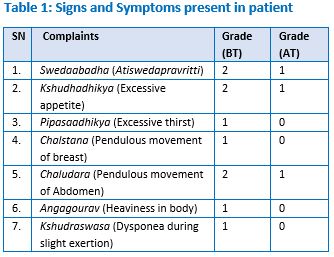Effect of Shunthi-Haritaki Choorna and Kapalbhati in Sthaulya (Obesity): A Case Study
DOI:
https://doi.org/10.21760/jaims.8.5.37Keywords:
Shunthi - Haritaki Choorna, Kapalbhati, Sthaulya, Obesity, BMI.Abstract
Obesity is a medical condition where body fat has accumulated to an extent that it may have a negative effect on health. A body mass index (BMI) over 25kg/m2 is considered overweight, and over 30kg/m2 is obese. Modernization, stress, bad dietary habits and sedentary lifestyle results into the clinical entity called obesity. In Ayurveda, it has been mentioned under Santarpanjanya Vikara in Bahudoshavastha condition. Ayurveda has a holistic approach towards management of Sthaulya. This is a single case study on effective management of Sthaulya. The treatment was planned as Shunthi-Haritaki Choorna in a dose of 5 gm [2:1] with lukewarm water B.D. after meal and Kapalbhati - 3 rounds (with 1 minute interval of normal breathing) in morning time. Each round will have 4 cycles of 20 strokes (with an interval of 3-4 deep breathing) for 45 days. After completing 45 days, patient felt significant changes in the anthropometrical measurements of the body, along with weight reduction of about 4.2kgs. And improvement in other associated symptoms as well as lipid profile. The current study thereby proves that treatment with Shunthi-Haritaki Choorna and Kapalbhati is a good way to manage overweight and obesity.
Downloads
References
Joshi (deole) Supriya et al. Management of overweight and Obesity through specific
Supriya Joshi (Deole), Yogesh S Deole, GH Vyas, SC Dash. Management of Overweight and Obesity through specific Yogic procedures. Ayu-Vol.30 No.4 (October – December) 2009, pp 425-435.
Tripathi B. Charaka Samhita, Sutra Sthana, Ashtouninditiya Adhyaya In: 21/4, vol-I 4th ed 1995, Chowkhamba Surbharti Prakashan, Varanasi: 1995; p.398.
Acharya J.T., Acharya N.R., Sushruta samhita of Sushruta, Nibandha sangraha vyakhya of Dalhana. Chapter 15. Vers 38. Part 1. Varanasi: Chaukhambha orientalia, 7 Edition 2002.P.75.
Juang LJ, Sheu SJ, Lin TC. Determination of hydrolyzable tannins in the fruit of Terminalia chebula by high-performancc liquid chromatography and capillary electrophoresis. J Sep Sci. 2004;27(9):718–724.
Stoner G.D. Ginger: Is it ready for prime time? Cancer Prev. Res. 2013;6:257–262. doi: 10.1158/1940-6207.CAPR-13-0055. [PubMed] [CrossRef] [Google Scholar].
Meher Sudhanshu et al. Pharmacological Profile of Terminalia chebula Retz. and Willd. (Haritaki) in Ayurveda with Evidences. RJPPD.2018; 10(3):115- 124.
Dinkar R Kekan et al. effect of Kapalbhation body mass index and abdominal skinfold thickness at overweight resident doctors.S.R.T.R. Medical College Ambajogai; 2013.















